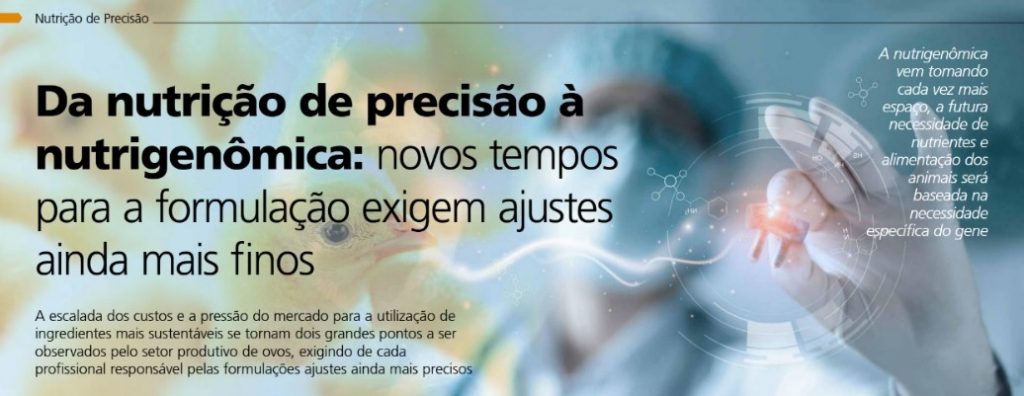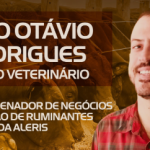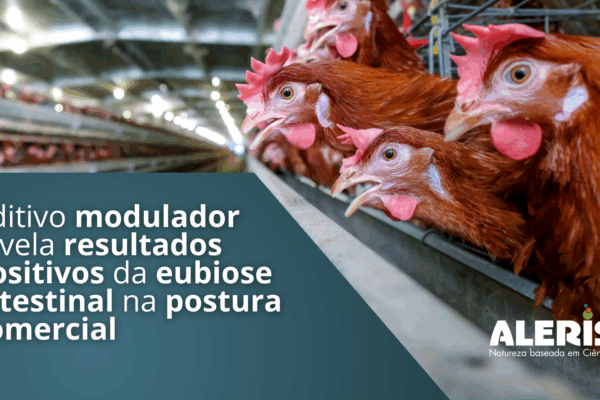From precision nutrition to nutrigenomics: new times for formulation require even finer adjustments.
With rising costs and market pressure to use more sustainable ingredients, these become two major points to be observed by the egg production sector, requiring even more precise adjustments from each professional responsible for formulations.
In laying hen nutrition, the application of the concept of precision nutrition translates into the use of formulations that come as close as possible to the bird's nutritional requirements with the aim of maximizing production potential. The objectives of this maximized production must include efficiency in the use of available resources and sustainability. And this involves the well-being of flocks of laying birds and consumer health, aiming to apply the concept of one health. In short, our role as professionals is to maximize the efficiency of using the nutrients offered to the birds throughout the production periods with the aim of minimizing the environmental impacts of a given production.
Initially, we consider the components of the diet that can affect the use of energy, protein and other components such as: vitamins, minerals and their interrelationships. For the layer nutritionist, the best formulation scenario is one where it is possible to have more ingredient options on the shelf to meet the requirements that a diet must meet (cost-benefit).

Mariana Nascimento has a degree in Animal Science from the Federal University of Espírito Santo, a Master's degree in Veterinary Sciences, a PhD in Animal Science from the Universidade Estadual Paulista (UNESP) and Technical Coordinator at Aleris.
However, ingredients such as corn and soybean meal, for example, although they are considered commodities, are used as the main source of energy and protein, respectively. Despite the “commodities” classification, we always need to treat them as ingredients with first and last names in the sense that we always evaluate, through prediction equations, the nutritional value closest to what we are dealing with at that particular moment in the formulation and not just considering the results presented in the nutritional tables, since this point depends on a complex scenario that includes production characteristics and productive level of each cultivar. Therefore, when we talk about alternative foods, we must demystify this idea of “alternative” a little and treat them as ingredients that should be routinely present on the nutritionist’s shelf to be used whenever they are viable in the formula. Ingredients such as wheat bran, triticale, oats, sorghum and yeast-based products are some examples of ingredients still treated as “alternatives”, but which could be very viable in different production realities.

When we think about ingredients that are main sources of energy, we will naturally make a comparison with corn, which today is our biggest reference for energy ingredients, but we need to keep in mind that each ingredient has its own nutritional characteristics and that we cannot ignore them. For example, when we compare corn with primary corn yeast plus its fermented fractions, this ingredient has a lower metabolizable energy, since the composition of carbohydrates and lipid contribution of this ingredient is different from the composition of carbohydrates and lipids in corn. However, this could be an ingredient that would make formulations very viable due to other functional and protein characteristics. This is also the case with soybean meal, if we think about it, the carbohydrate composition is also different from the composition of other ingredients. And this difference in composition can directly influence the efficiency of energy use that each ingredient has for each animal species, such as pigs, which are able to make better use of the energy content of this ingredient than birds. But why this happen? Because the anatomy and physiology of the gastrointestinal tract in birds is different from that in pigs. The relationship between the intestinal microbiota and pigs is much more “friendly” as their anatomophysiological structure provides a longer substrate fermentation time when compared to birds. Thus, in a situation where we offer the same soybean meal, for pigs it contains 3,179 Kcal/kg of metabolizable energy (ME), but for a laying bird it contains 2,341 Kcal/kg of ME. Where do we lose 838 Kcal? We lost due to the constitution of carbohydrates that this same ingredient is present for these two different species, that is, the ingredient may be the same, but the ability to digest it is different.
In the past, we did not have predictive models to help with finer adjustments and more efficient ingredient changes considering multivariate scenarios as we can today. The formulation work was based much more on intuition and long experience built on the basis of many mistakes and successes by nutritionists. With the dissemination and constant improvement, aiming at the robustness of prediction models, it was possible to consider price fluctuations together with all the bromatological information on any ingredient so that decision-making is not disconnected from the reality of cost or nutritional reality. Furthermore, today there are companies such as Aleris Nutrição Animal that are working to add another important variable to this equation, the impact of the composition of the microbiota on the animal's digestive process and physiology.
Therefore, taking into account the premise that a considerable part of the microbiota adapts to the diet and conditions of the host, reflecting on its performance, health and well-being, how changing (partial or total) an ingredient can affect the benefit from a certain diet? Or, how can a certain physiological state affect the composition of the microbiota and consequently how this microbiota profile is impacting the animal? These and many other questions that we seek to answer to further improve our understanding of the animal system.
However, it is very important to make it clear that mathematical models are tools that facilitate more integrated decision-making, but they do not replace bromatological results and prices of batches of ingredients received or even human resources.
To make precision nutrition a reality, feed producers need to change the way they view ingredients as simply always uniform, but rather how they should be analyzed to exactly match the desired nutritional specification. The analysis will help to formulate an economical diet that is closer to the animal's requirements. Without knowledge of ingredient analysis, accurate nutrition becomes unfeasible, even with the best diet formulation. Followed by ingredient selection and diet formulation, post-absorptive processes that classify food raw materials based on digestibility coefficients need to be considered. Use of advanced analytical techniques such as near-infrared spectroscopy (NIR), inductively coupled plasma optical emission spectrometry (ICP-OES) for mineral profiling, and gas chromatography-mass spectroscopy (GC-MS) for contaminants (e.g., pesticides ) and tests in vitro for nutrient profiling and antinutrients provide more nutrient values to help achieve a more accurate diet formulation. We can achieve the goal of precision nutrition through more precise feed formulation based on the nutritional value of each batch of ingredient, proper weighing and mixing of ingredients, new feed processing techniques, and continued use of feed additives.
In addition to these tools that add a lot of knowledge to the nutritionist at the time of formulation, nutrigenomics is taking up more and more space, the future need for nutrients and animal nutrition will be based on the specific need of the gene. In modern nutrition, generic recommendations will be replaced by personalized solutions. Using nutrigenomics as a tool in animal nutrition allows us to develop new feeding strategies, thus creating an opportunity to reduce material costs, improve supplementation and quickly adapt new formulations in response to changing markets and demands. It also allows us to identify and address nutritional bottlenecks that prevent us from taking advantage of advanced genetics.
Nutritional manipulation of the microbiota and the ability of the microbiota to influence gene expression in the animal aim to control specific gene expression by under- or overfeeding some nutrients and compounds. Through precision nutrition, additives developed based on animal microbiota biomarkers can be supplied at defined periods to obtain the desired changes in gene expression for greater production, for example: laying birds with greater laying persistence, lower rate of dirty eggs, between others.
Finally, all these technologies for analyzing and mapping physiological routes in the animal are support tools when building the scenario for decision making, however, it will always be up to the nutritionist to evaluate the nutritional contribution and impact of including any element in the diet of this animal without compromising performance or negatively affecting the quality of feed. In this sense, integrated knowledge is essential for nutritional adjustments to be made to the final feed.
About the author: Mariana Nascimento has a degree in Animal Science from the Federal University of Espírito Santo, a Master's degree in Veterinary Sciences, a PhD in Animal Science from the Universidade Estadual Paulista (UNESP), with work, research and publications in the area of poultry and swine nutrition. She is currently Technical Coordinator at Aleris Nutrição Animal.
About Aleris – Founded in 2012, Aleris is a national company specializing in animal nutrition, committed to offering natural solutions for maximum performance and health for production animals and pets. Currently, through its global operation and subsidiaries in the United States, Mexico and Portugal, the company exports its solutions in natural yeast-based additives to more than 32 countries.
Author













